 |
| Maya au bateau (Maya with boat) 1938 private collection |
Picasso had four children with his numerous wives and girlfriends. Maya was his first daughter by Marie-Thérèse Walter, a young woman he met by chance outside the Galeries Lafayette store in 1927. Picasso was 45; Marie-Thérèse was 17.
 |
| Guitare à la main blanche (Guitar with white hand) 1927. Private collection |
Picasso disguised his new mistress and model in such paintings as the above, where Marie-Thérèse Walter's initials appear on the guitar. Later she appeared in her full beauty:
 |
| Portrait of Marie-Thérèse 1935 Pencil. Private collection |
Her gymnastic body was sometimes transformed into rocks and boulders in beach scenes by Picasso, while her distinctive 'Greek' profile and blonde youth is recognizable in several works:
 |
| Portrait de Marie-Thérèse 1937 oil and pencil |
When Maya's imminent birth was discovered by Olga, Picasso's Russian ballet dancer wife, the turmoil caused led to their separation.
Maya became a beloved model for her father.
 |
| Première Neige (First Snow) 1938 private collection |
Picasso's inventive mixing of chalk, charcoal and oilpaint creates the effect of pastel.
Picasso's first daughter was given the same name as his own sister who had died aged 2 - Maria de la Concepciòn, shortened to Maya. She was born in September 1935. During the second world war period Picasso created make-shift toys for her out of recuperated materials, left-overs from his studio. Some of these are on show.
Father and daughter's complicity is evident in Maya's notebooks where both she and Picasso drew and gave each other marks out of ten for their drawings. Picasso painted Maya in many guises:
 |
| Maya en costume marin (Maya in a sailor suit) 1938 (MOMA, New York) |
The artist expresses the joy of childhood. Picasso has signed his name on Maya's beret, claiming paternity for his work and for Maya. How banal is Picasso's father, Don José's work by comparison!
 |
| Palomar (Pigeon loft) by José Ruiz-Blasco 1878 |
 |
| Tiki, from Marquesas Islands 19th C Wood, traces of paint |
| The above artefact was part of Picasso's collection, inspiring him with its schematized forms, its trunk-like legs and hands held out like shovels, in the typical style of the Tiki figures from Polynesia. Picasso's Dada or Surrealist period is exemplified by the work below: |
Picasso called it "La Venus du gaz" Cooker burner. 1945. People might say "Anyone could do that- just turn a gas burner vertically". True, but Picasso DID it! Just as Marcel Duchamp turned a gentleman's urinal round and called it "Fountain". A copy of the outrageous Duchamp is on display, next to Picasso's "Gas burner Venus".
 |
| El Bobo (The idiot boy) 1959 |
 |
| Tete d'homme, (Head of a man) Mougins 1971 |
 |
| Emilie Marguerite Walter (dite "Mémé") 1939 |





I really like your blogs. They teach me something new every time. You show me aspects of art which I would never have observed on my own. If only I could remember everything you have explained! Still. It makes me try to find more meaning when I look at artwork these days and I can always reread your blogs.
ReplyDelete